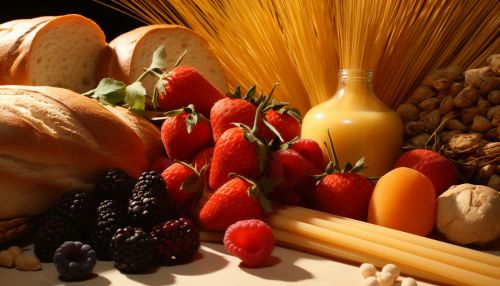Carbohydrate
Overview
Carbohydrates are a type of macromolecule found in many foods and living tissues. They include sugars, starch, and cellulose. They are an essential part of the diet and provide the body with energy. Carbohydrates are classified into three types: monosaccharides, disaccharides, and polysaccharides.


Structure and Classification
Carbohydrates are organic compounds composed of carbon, hydrogen, and oxygen atoms. The ratio of hydrogen to oxygen is usually 2:1, similar to that in water. The basic structure of carbohydrates is a sugar molecule, and they are classified according to the number of sugar molecules they contain.
Monosaccharides
Monosaccharides are the simplest form of carbohydrates. They consist of a single sugar molecule and cannot be broken down into simpler sugars. Examples of monosaccharides include glucose, fructose, and galactose.
Disaccharides
Disaccharides consist of two sugar molecules bonded together. Examples include sucrose (table sugar), lactose (milk sugar), and maltose (malt sugar).
Polysaccharides
Polysaccharides are complex carbohydrates that consist of many sugar molecules bonded together. They include starch, glycogen, and cellulose. Starch and glycogen are used as energy storage in plants and animals, respectively, while cellulose is a structural component of plant cell walls.
Function
Carbohydrates serve several key functions in living organisms. They are a primary source of energy, provide structural support in plants and arthropods, and are involved in cell-cell recognition and communication in animals.
Energy Source
Carbohydrates are a primary source of energy for most organisms. During digestion, carbohydrates are broken down into their constituent sugars, which can be used to produce ATP (adenosine triphosphate), the body's main energy currency.
Structural Role
In plants, the polysaccharide cellulose provides structural support to cell walls. In arthropods, the polysaccharide chitin forms the exoskeleton.
Cell-Cell Recognition and Communication
Certain carbohydrates, known as glycoproteins and glycolipids, are involved in cell-cell recognition and communication. These molecules are found on the surface of cells and play a key role in the immune response and other cellular functions.
Dietary Sources and Requirements
Carbohydrates are a key component of the human diet. They are found in a wide range of foods, including fruits, vegetables, grains, and dairy products. The recommended dietary allowance (RDA) for carbohydrates for adults and children aged 1 and older is 130 grams per day.
Health Effects
While carbohydrates are essential for health, excessive consumption can lead to health problems such as obesity, type 2 diabetes, and heart disease. Conversely, insufficient carbohydrate intake can lead to nutritional deficiencies and energy shortages.
